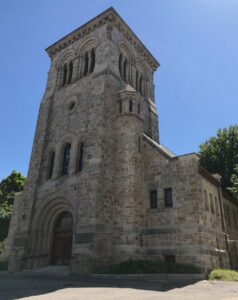 On a glorious late spring afternoon, just days before the solstice and the return of summer, I should have been jostling with the crowds on my visit to Plymouth, Massachusetts. I should have been standing on the hot pavement waiting my turn to see the sanctuary of the beautifully restored First Parish Church in Town Square. Should have been in a long line snaking its way to the pavilion to get a glimpse of Plymouth Rock, after which I should have been climbing the hill for a tour of the eighteenth-century Edward Winslow House, built by the great-grandson of Pilgrim Edward Winslow, and now the headquarters of the General Society of Mayflower Descendants. I should have been among the throngs visiting the humble thatched homesteads of the Pilgrims at the recreated Plimoth Plantation, watching them cultivate their gardens and listening to them recount stories of their first years in the New World.
On a glorious late spring afternoon, just days before the solstice and the return of summer, I should have been jostling with the crowds on my visit to Plymouth, Massachusetts. I should have been standing on the hot pavement waiting my turn to see the sanctuary of the beautifully restored First Parish Church in Town Square. Should have been in a long line snaking its way to the pavilion to get a glimpse of Plymouth Rock, after which I should have been climbing the hill for a tour of the eighteenth-century Edward Winslow House, built by the great-grandson of Pilgrim Edward Winslow, and now the headquarters of the General Society of Mayflower Descendants. I should have been among the throngs visiting the humble thatched homesteads of the Pilgrims at the recreated Plimoth Plantation, watching them cultivate their gardens and listening to them recount stories of their first years in the New World.
Instead, the sites were, for the most part shuttered, and the town was empty of visitors but for small clusters along the waterfront who were enjoying the sunshine, a slight salty breeze, and a take-out lunch. The wide swath of emptiness from Water Street up Leyden Street and into Town Square made it seem more like a runway at Logan Airport than the congested historic corner of Plymouth that it usually is. There’s no need to state the obvious. The coronavirus has turned 2020 on its head, and among the countless casualties and crushing disappointments – for those of us who care about such things – are all the now-dashed grand plans, here and abroad, to celebrate the Pilgrim quadricentennial. I’d have sooner expected the statue of Governor Bradford to step off his pedestal and start reading from his Journal than to see all the years-long dedication and planning for 2020 go poof! before our eyes. All need not be lost, however. With a little creativity one can, as I did, fashion one’s own Mayflower 400 peregrination.
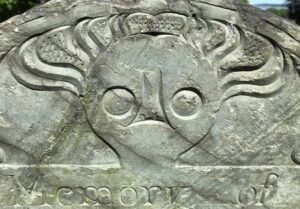 Despite the perfect weather day, most everyone along the Plymouth waterfront was wearing a mask, as has become the new social norm. If the human face and its complex, coordinated system of expressions is part of an array of cues that help us to navigate social situations, the covering of the face during the virus has robbed us of a tool in our toolbox, forcing us to find new ways of “reading,” communicating with, and understanding one another. Psychologists tell us that facial nerves and muscles are the physical part of the body that is the least able to be fully controlled. In other words, the face cannot be completely disengaged from the body’s psychology. Thus, the face, across which life and lessons are etched, is something of a truth teller.
Despite the perfect weather day, most everyone along the Plymouth waterfront was wearing a mask, as has become the new social norm. If the human face and its complex, coordinated system of expressions is part of an array of cues that help us to navigate social situations, the covering of the face during the virus has robbed us of a tool in our toolbox, forcing us to find new ways of “reading,” communicating with, and understanding one another. Psychologists tell us that facial nerves and muscles are the physical part of the body that is the least able to be fully controlled. In other words, the face cannot be completely disengaged from the body’s psychology. Thus, the face, across which life and lessons are etched, is something of a truth teller.
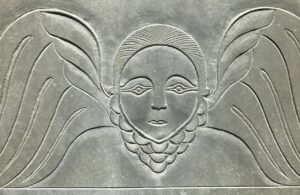 Generally speaking, we recognize people by their facial features; in our daily interactions we process faces holistically, integrating all the features. Take away any of those features and even our friends and neighbors can be unrecognizable. The eyes and mouth are the most expressive parts of the face and with its tangle of lip muscles, the mouth sends out cues as to a person’s approachability, their friendliness. Face coverings take away those important cues. How can we know if a welcoming expression is behind that mask? How can we know whether to engage that person during the common experience of, say, staring down at the Plymouth Rock or reading the inscription on the Bradford statue? Did he or she just offer a fleeting smile, an acknowledgment that perhaps we share something in common? Do I strike up a conversation? Though social cues are also sent with eye contact (provided sunglasses are not being worn), masks impose a boundary that separates us from others. Individuality – our own and everyone else’s – blurs into a sea of surgical baby blue and industrial white. And so we stand there, islands unto ourselves, or drift past one another in our own bubble.
Generally speaking, we recognize people by their facial features; in our daily interactions we process faces holistically, integrating all the features. Take away any of those features and even our friends and neighbors can be unrecognizable. The eyes and mouth are the most expressive parts of the face and with its tangle of lip muscles, the mouth sends out cues as to a person’s approachability, their friendliness. Face coverings take away those important cues. How can we know if a welcoming expression is behind that mask? How can we know whether to engage that person during the common experience of, say, staring down at the Plymouth Rock or reading the inscription on the Bradford statue? Did he or she just offer a fleeting smile, an acknowledgment that perhaps we share something in common? Do I strike up a conversation? Though social cues are also sent with eye contact (provided sunglasses are not being worn), masks impose a boundary that separates us from others. Individuality – our own and everyone else’s – blurs into a sea of surgical baby blue and industrial white. And so we stand there, islands unto ourselves, or drift past one another in our own bubble.
Though social cues are also sent with eye contact (provided sunglasses are not being worn), masks impose a boundary that separates us from others.
Having enjoyed my outdoor tour of the waterfront sites, I headed up to Old Burial Hill behind First Parish. The current church building, the fifth to occupy the site, was recently donated by the congregation to the General Society of Mayflower Descendants, which will now care for the historic building, built in 1897, and its church records dating back to 1620. From atop Old Burial Hill, which rises about 170 feet above sea level, one can take in an impressive panorama of the coastline and, if the day is clear, get a glimpse, as I did, of Provincetown across the bay. When I am in Provincetown, I always contemplate the gauzy purple headland across the bay and imagine that the Pilgrims, while exploring the outer Cape for five weeks after landing at Provincetown, must have been wondering “What’s that place over there?”
I could make out clearly Provincetown’s Pilgrim Monument, 252 tall and 350 feet above sea level. Seeing it so distinctly felt like locking eyes with an old friend from across a vast, empty room. One wonders if, after establishing their village at Plymouth, the Pilgrims stood atop Burial Hill, gazed across to the Provincetown headland, and contemplated the unforeseen circumstances that had first landed them there.
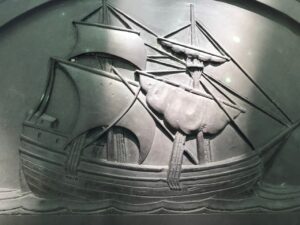 Old Burial Hill, an original landmark and designated National Register of Historic Places property, was an integral part of the 1620 Pilgrim village and the site of the Pilgrim’s first fort/meetinghouse. It is believed to be the final resting place of several Mayflower passengers, including Elder William Brewster and his wife Mary (marked by a cenotaph), Governor William Bradford (marked by an obelisk), and John Howland (marked by an 1897 monument with an elegant bas relief of the Mayflower). Criss-crossed by paths, the sacred ground was an active burial ground for nearly 300 years. The headstones and monuments number nearly twenty-three hundred, many of which are irreplaceable works of folk art.
Old Burial Hill, an original landmark and designated National Register of Historic Places property, was an integral part of the 1620 Pilgrim village and the site of the Pilgrim’s first fort/meetinghouse. It is believed to be the final resting place of several Mayflower passengers, including Elder William Brewster and his wife Mary (marked by a cenotaph), Governor William Bradford (marked by an obelisk), and John Howland (marked by an 1897 monument with an elegant bas relief of the Mayflower). Criss-crossed by paths, the sacred ground was an active burial ground for nearly 300 years. The headstones and monuments number nearly twenty-three hundred, many of which are irreplaceable works of folk art.
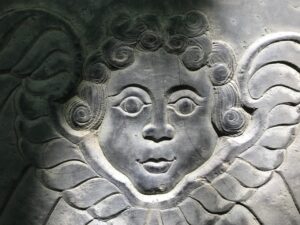 As I strolled the cemetery, what struck me most during our new covid-cotton-cloth-covering climate was how elated I was to see all the little faces, full faces, some stern, some contemplative, but many playful, staring back at me from the headstones. The interplay of light on the stones and the angle at which I studied them seemed to make the slates and their soul effigies and portraits come alive, made them seem interactive. They were inviting, welcoming. One little face, wide-eyed and looking as though its hair is on fire, seemed to express perfectly everyone’s response to the emotional strain, anxiety, and worry that have consumed the world since late winter. Several faces seemed to react to my gaze in the same way that many describe their encounter with the Mona Lisa and her elusive smile. Was it my imagination, a longing for social interaction sans masks, or did those eyes wink and twinkle, did the corners of those lips turn up into a wider grin, mysterious and mischievous? The faces made me smile back, as though we were heartily in agreement about something.
As I strolled the cemetery, what struck me most during our new covid-cotton-cloth-covering climate was how elated I was to see all the little faces, full faces, some stern, some contemplative, but many playful, staring back at me from the headstones. The interplay of light on the stones and the angle at which I studied them seemed to make the slates and their soul effigies and portraits come alive, made them seem interactive. They were inviting, welcoming. One little face, wide-eyed and looking as though its hair is on fire, seemed to express perfectly everyone’s response to the emotional strain, anxiety, and worry that have consumed the world since late winter. Several faces seemed to react to my gaze in the same way that many describe their encounter with the Mona Lisa and her elusive smile. Was it my imagination, a longing for social interaction sans masks, or did those eyes wink and twinkle, did the corners of those lips turn up into a wider grin, mysterious and mischievous? The faces made me smile back, as though we were heartily in agreement about something.
Share this:
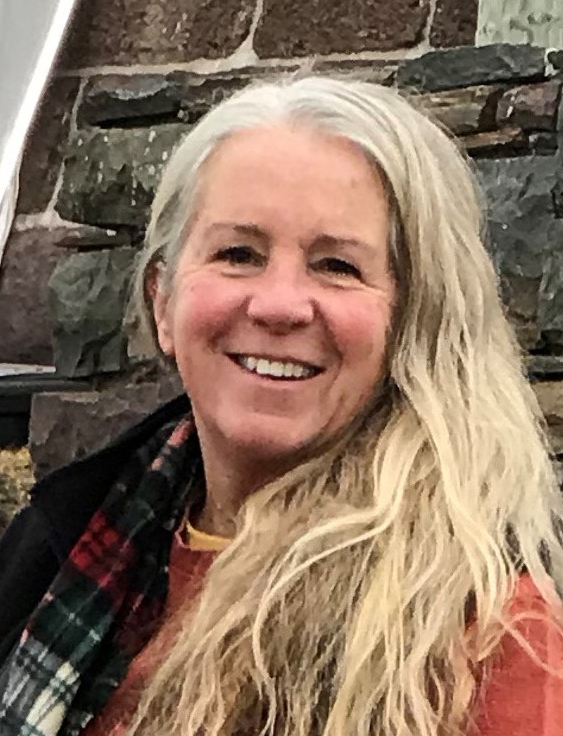
About Amy Whorf McGuiggan
Amy Whorf McGuiggan recently published Finding Emma: My Search For the Family My Grandfather Never Knew; she is also the author of My Provincetown: Memories of a Cape Cod Childhood; Christmas in New England; and Take Me Out to the Ball Game: The Story of the Sensational Baseball Song. Past projects have included curating, researching, and writing the exhibition Forgotten Port: Provincetown’s Whaling Heritage (for the Pilgrim Monument and Provincetown Museum) and Albert Edel: Moments in Time, Pictures of Place (for the Provincetown Art Association and Museum).View all posts by Amy Whorf McGuiggan →